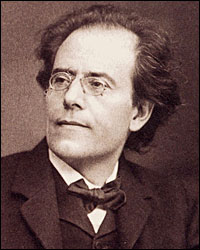Touched by Four Angels
 Composer Mark Adamo (b. 1962) Photo by Martin Gram, courtesy of G. Schirmer, Inc. |
Adamo dedicated the third movement, Regina Coeli (not an angel at all, but the Mother of God, Queen of Angels), to his mother. It is a gentle aria for luscious Hollywood strings, with the percussion banished from the gentle atmosphere, ending on a thick A-flat major chord. A melody of fourths and fifths, which appears regally in the first movement and enigmatically in the scherzo, is smoothed out here and serves to unify all four movements. The fourth movement, Mik'hail, is a restless description of that most militaristic angel, common to Judaism, Christianity, and Islam. The martial sounds included muted trumpet fanfares, and the movement's use of agitated shifting meters and driving rhythms brought the work to a triumphant end. Four Angels is pleasing to the ears in a neo-Romantic way (Adamo reportedly wanted to be a Broadway composer), but it gives the impression of being an episodic series of vignettes more than a formally unified work. With his extraordinary skill at quickly evoking different moods and characters, Adamo has likely missed his real calling, in composing film scores.
Tim Page, NSO Takes Flight With 'Four Angels' (Washington Post, June 8) Karren L. Alenier, Mark Adamo's Harp Concerto (The Dressing, June 8) Stephen Brookes, Composer Mark Adamo, Wild at Harp (Washington Post, June 3) |
 The second half offered the main attraction for many in the large if not full audience, Gustav Mahler's first symphony. The last time we reviewed the "Titan," as it is sometimes labeled (you can listen to it online), it was Jens's review of guest conductor Roberto Abbado in 2004, but the NSO has played it since then another time, at Wolf Trap in 2005. Mahler-1 three times in three years, and La Reine once every fifteen years? A work so familiar should have come off more solidly than it did overall, too. The second movement had a gutsy quality that made it a rather rustic Ländler, with a sultry salon dance trio. The enigmatic third movement is a somber funeral march with the children's song Bruder Martin as a theme -- you may know it instead as Frère Jacques, but recast in the minor mode. This was a moment of chilling irony, interspersed with interludes in a Jewish or Gypsy style, to which Slatkin gave a joyous, Klezmer-esque flavor. The turn to the major mode, for the appearance of Mahler's achingly beautiful song melody Die zwei blauen Augen was beautifully hushed and tender playing.
The second half offered the main attraction for many in the large if not full audience, Gustav Mahler's first symphony. The last time we reviewed the "Titan," as it is sometimes labeled (you can listen to it online), it was Jens's review of guest conductor Roberto Abbado in 2004, but the NSO has played it since then another time, at Wolf Trap in 2005. Mahler-1 three times in three years, and La Reine once every fifteen years? A work so familiar should have come off more solidly than it did overall, too. The second movement had a gutsy quality that made it a rather rustic Ländler, with a sultry salon dance trio. The enigmatic third movement is a somber funeral march with the children's song Bruder Martin as a theme -- you may know it instead as Frère Jacques, but recast in the minor mode. This was a moment of chilling irony, interspersed with interludes in a Jewish or Gypsy style, to which Slatkin gave a joyous, Klezmer-esque flavor. The turn to the major mode, for the appearance of Mahler's achingly beautiful song melody Die zwei blauen Augen was beautifully hushed and tender playing.The first movement featured some nice offstage brass playing, as well as dolorous woodwind intonation in those slow, exposed passages. Here as in the rousing final movement, the brass were apocalyptic and showed almost superhuman strength. At the moment when Mahler asks the horn section to stand together and play the triumphant chorale theme, it was thrilling to hear. The brass were also largely responsible for making the symphony's exultant conclusion as full and final as it was. So, there was good and bad (or less good) in this worthy program, which ends the NSO's 2006-07 season with hope for the future.
This concert will be repeated once more, this evening at 8 pm. The National Symphony now moves into its summer schedule, with some lighter concerts at Wolf Trap through August. Regular concerts will return to the Kennedy Center in September.





















































No comments:
Post a Comment